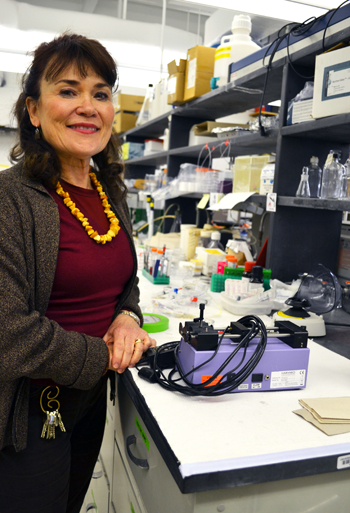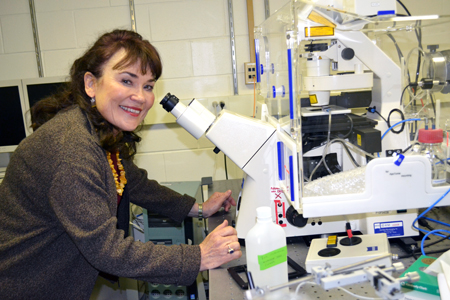Martha Gillette's Favorite Dish? Interdisciplinary Research

Martha Gillette, Professor of Cellular and Structural Biology
February 5, 2013
Martha Gillette has always been a maverick. For years, she has been a pioneer in interdisciplinary research—comfortably rubbing shoulders with chemists and engineers and, for a biologist, thinking outside the box.
Gillette calls herself a neuroscientist and biologist; in many of the collaborative projects in which she’s been involved, such as the NSF-funded EBICS (Emergent Behavior of Integrated Cellular Systems) project, she’s the “token biologist.” However, based on her current research—emerging technologies for studying neurons—which uses engineering approaches to study neuro-development, she appears to be veering over into neuroengineering. For example, in her EBICS project, she’s using microfluidic devices to create an environment similar to the brain to study how neurons work at a sub-neuron cellular level. Her tendency to gravitate toward engineered devices as containers for studying the brain, and specifically neurons, bewilders fellow biologists, who ask, “What are you doing this for? Why aren’t you just using a petri dish?!”
EBICS isn't Gillette's first exposure to interdisciplinary collaboration—or her first time dabbling in engineering. In an early collaborative study with two chemists, they built micro-fluidic devices. Their goal: to make environments where they could grow single neurons and differentiate where the neurons' extensions go. (Extensions are what neurons communicate with.) Thus, they sought to design devices in which they could actually shape how the neuron develops and control those environments and then sample what's released at individual terminals. Their project was funded by the prestigious Keck Award, which says it all: the Keck Foundation funds research so new and cutting edge that federal agencies won't even touch it.
Most of Gillette’s studies of the brain always seem to occur outside the human head and in some unusual receptacle. For instance, her signature research on the internal clock in the brain involves a big slice of brain in a dish where, like the Energizer Bunny, it keeps on ticking. “It’s extraordinarily interesting. I love it; I love it; I love it!” gushes Gillette. “Because it’s this natural clock that oscillates, and it repeats it, and you have to build it out of cells and molecules. How interesting is that?!” She recalls the triumph of the project’s early success: “We were the first people to really get it ticking for multiple days in an artificial environment.”
Another unique characteristic of Gillette’s work is that it tends to be interdisciplinary. According to Gillette, interdisciplinary collaboration works at Illinois because people are committed to it and, thus, willing to compromise. “One unusual thing, I think, about Illinois is that people are so collaborative and easy to interact with. For STEM programs to work, people have to give a little bit of themselves. They have to step out of what they’ve been doing in their comfort zone and make a little time to work across the discipline. You have to make that commitment. People aren’t going to come to where you are; you’ve got to go to a middle ground…But the opportunities, and the gains, and the self-fulfillment of doing interesting things is just so great that they need to be confident to make that step…Our faculty are much more amenable to that kind of thing than many are. It’s a real strength of Illinois.”
While working with people from other disciplines can sometimes prove challenging, Gillette believes that it can also be a strength. For example, the Neuroengineering IGERT at Illinois, another of her interdisciplinary projects, gives students from different disciplines the opportunity to interact and learn from each other. Says Gillette, “That’s what’s wonderful about these training opportunities. They get students from different backgrounds working together, and you look at things differently.”

Martha Gillette uses a microscope in her lab in Morrill Hall.
It has been her experience that researchers from different fields analytically think about problems differently. For example, the way her biology students approach a problem is different than the way engineers do. “They’re going to have a different idea about interfacing with biology because they’ve been sort of steeped in the way biologists think about it, which is a little different if you come from a more engineering background where you look at certain parts of machines or elements that can be reduced to a role in how something works. That’s not the way biologists think of things. We think of things as problems that need to be solved.”
But she believes coming at problems from differing viewpoints can benefit research. “I think that’s part of the excitement. In studying the brain, we can look at things with engineering tools, and engineering viewpoints, but we’re still looking at it as a living process that we want to understand. It’s the other side of the coin from how an engineer looks at biology.”
One of the challenges inherent in interdisciplinary research, according to Gillette, is communication: “It isn’t easy, because you speak a different language for one thing. Everyone’s got their own jargon, and I’m constantly trying to tell my students, ‘We’re speaking in jargon now. You have to speak in a way that someone not part of the inside group can understand. You have to get it in a real person's language.’”
She exhorts her students that learning to describe their research in language a lay person can understand is a skill that will help them career-wise down the road: “It’s good for you to know that because you can’t go out and talk to the big wide world or your senators or your legislators if you can’t speak that language.”
As cutting-edge as her research has been throughout her whole career, does she still see her personal research changing? “Oh I do. I am certainly influenced by the engineers. There’s no question. Those guys are interesting, bright, creative people.”
And Gillette has been influenced by engineers more than she knows. She recently wrote a journal article about her new approach for biologists using microflouidic environments to study neurons, which, she predicts, “will make a big splash in the neuroscience community.” Ironically, she discovered that it wasn’t biology jargon but engineering jargon she had to purge from the paper. After working with engineers for at least eight years, she had become so familiar with their lingo that it had crept into her writing—so much so that her peers in biology who were reviewing the article had issues. “It took a long time to get this published, because we had to get the jargon out of it. Even though we’re not engineers, the jargon had crept in.”
Gillette has been at Illinois since 1978; however, she’s only been on the faculty since 1988. She reports that, in the early days, she was on soft money. However, she recalls that a position on faculty opened up after her early success with her brain-clock-in-a-dish research: “When we got the brain slice in the dish working, that was a big sort of splash."
Gillette finds her job at the University to be very fulfilling. First, her research is very rewarding. "I love doing research, it’s just very exciting. It’s just what I like to do—discovering things. So I feel really lucky."
She also finds great joy in mentoring the students who pass through her programs. While they’re all in different areas and have different interests, “They’re kind of one big family.” She proudly recalls one student, Gordon Buchanan, who came to Illinois as an undergrad, started working in her lab as a grad student, got his M.D.-Ph.D. at Illinois, and is now on faculty at Yale.
When Buchanan first joined her lab, he worked on understanding how caffeine affects the brain's circadian clock, using Gillette's "bread-and-butter technique of single unit electrophysiology from hypothalamic brain slices." In charge of equipment and overseeing animal protocols, his big contribution to the lab was setting up the wheel-running behavior system and surgery techniques. Buchanan reports that his time in Gillette's lab equipped him with both skills and confidence.
"Martha was and is so well known and well liked both on campus and nationally/internationally, I felt a sort of instant credibility when I would tell people I worked with her. She also helped to instill confidence by quickly letting me work independently...and also by giving a large project to get going on my own. Gaining this confidence, as well as some technical skill really helped me thrive in my time there. These have also helped me immensely through residency, my postdoc, and now as faculty at Yale."
Buchanan remembers pulling some all-nighters at the lab...and bumping into Gillette. "I would often stay in lab overnight to complete behavior experiments or do a long electrophysiological recording. Frequently, I would find that Martha was there in the lab too, always working on something. But, she would always take time to chat and hear about the experiments or whatever else I had going on."
One of Gillette's favorite things about working with students is the constant influx of new students, and seeing research through their eyes, which she finds refreshing. “I get to work with graduate students and undergraduate students and post-docs. Always new students coming in and getting interested in what’s going on in research. So it’s always spring.”
Author/photographer: Elizabeth Innes, Communications Specialist, I-STEM Education Initiative
More: EBICS, Faculty Feature, 2013













.jpg)
















